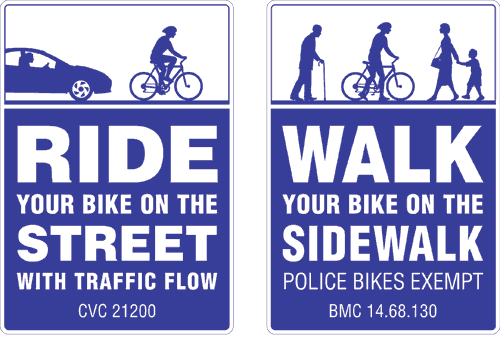SIDEWALK CYCLING LAWS

Biking on the sidewalk can sometimes feel like a safer option than riding in the street with traffic, but this behavior is in fact associated with many bicycle/car collisions. It also puts bicyclists in direct conflict with pedestrians, creating another potential hazard. Here are a couple tips you can follow to understand why you should avoid biking on the sidewalk, as well as some alternatives.
Is bicycling on the sidewalk legal?
The answer is maybe, depending on where you are. Traffic laws for bicycles in California are uniform, meaning they are the same in every city, with the exception of bike registration requirements and sidewalk cycling restrictions. This means that individual cities can decide whether or not biking on the sidewalk is allowed, in which parts of the city, and for whom. So, how does a bicyclist know what law applies to them in the city that they are traveling through at any given moment? In many cases it is not possible to know, so the best thing to do to ensure that you are riding legally is just avoid biking on the sidewalk altogether, and remain in the street instead.
Here is a list of all the cities in the East Bay, South Bay, and Peninsula, and the sidewalk cycling laws for each community. Keep in mind that although children are allowed to ride on the sidewalk in some cities this does not mean that they are required to do so. Also note that if a jurisdiction does not specifically regulate sidewalk cycling via their local code then it is permitted everywhere (the “No Data” column below):
If a sidewalk is designated as a “bike path” by a city then it is legal to bike on, although the same risks associated with sidewalk cycling may still apply.
Is bicycling on the sidewalk safe?
Sidewalks are designed to be used by people on foot, and are not expected to accommodate people traveling a bicycle speeds. The narrow width leaves little room to maneuver, and the number of concrete seams creates an uneven surface which may cause a crash. Also, drivers pulling out of driveways and side streets will not be expecting traffic moving the speed of a bicycle on the sidewalk and might not see or avoid you, even if you have the right of way.
If you do not feel comfortable riding your bicycle in the street on a specific stretch of roadway, try dismounting and walking your bike on the sidewalk until you reach a location where you can ride in the street again. However, if you do bike on the sidewalk for any reason, consider the following:
- Ride in the direction of traffic, not against it (cross the street to the opposite sidewalk if necessary)
- Keep your speed below 10 mph, as close to a walking pace as possible
- Yield to any pedestrians on the sidewalk, and when passing call out and use extreme caution
- Keep your distance from doorways or side paths, and always look for and yield to cars pulling out of driveways and side streets
Is bicycling in a crosswalk legal?
Again the answer is maybe. The California vehicle code defines sidewalks and crosswalks separately, which implies that for biking in a crosswalk to be illegal a city’s municipal code must specifically ban it, in addition to sidewalk cycling. However, a police officer or a judge may choose to interpret this legal grey area differently, so use your best judgement and when in doubt just walk your bike.
In any situation, a crosswalk connecting to a bicycle path is legal for bicyclists to ride in (per vehicle code section 21650g, and section 213.6), although standard right of way rules still apply.

